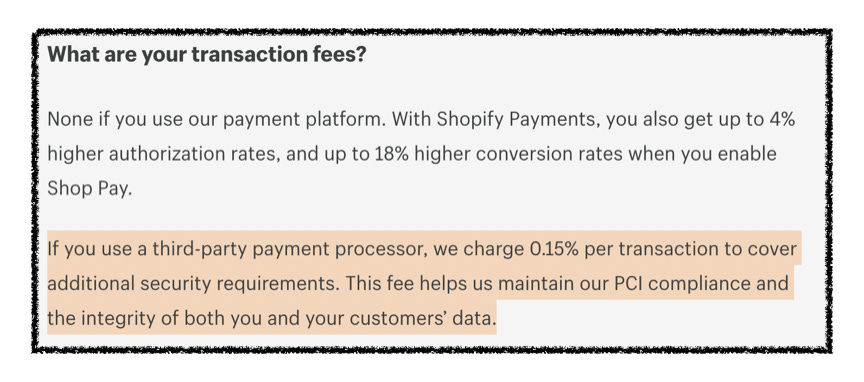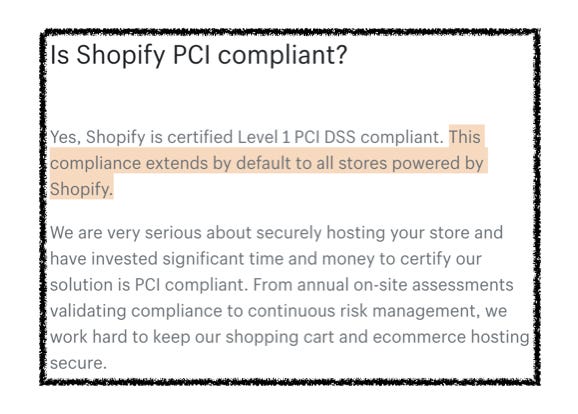Shopify's Underrated Lever
How Shopify's transaction fee drives revenue, upgrades, and customer lock-in.
SaaS Pricing is hard. PricingSaaS is your cheat code.
Monitor competitors, track real-time benchmarks, discover new strategies, and more.
Happy Sunday(ish) y’all!
This week, we’re back to analyzing a single company, and it’s one I imagine you’re all pretty familiar with: Shopify.
There is so much to dig into when it comes to Shopify’s packaging strategy, but today I want to dive deep on a single component that I find particularly underrated: their transaction fee. To be clear, I’m talking about the fee that they charge in addition to credit card processing fees.
I would love to hear your feedback. If you have thoughts, leave a comment or shoot me a note on Twitter!
On to this week’s analysis.
Briefing 📋
Shopify’s Transaction Fee: While all eCommerce platforms charge credit card processing fees, Shopify charges an additional fee for any sales that go through the platform. It’s a testament to Shopify’s product and ecosystem that merchants are willing to pay this extra “tax” to use their platform.
Shopify’s Win-Win: Merchants can avoid the transaction fee by using Shopify’s payment gateway, Shopify Payments. Therefore, merchants can either pay the fee, providing additional revenue for Shopify, or they can use Shopify Payments, further locking them into Shopify’s ecosystem. Either way, Shopify wins.
Shopify’s Upgrade Incentive: For customers that can’t use Shopify Payments, or prefer another payment gateway, the fee is mandatory. Since the rates decrease with each successive tier, it acts as a powerful incentive and gives customers a reason to want to upgrade.
Shopify’s Transaction Fee
While digging into Shopify’s transaction fee, I kept coming back to one question. If most of their competitors don’t charge an additional transaction fee, how does Shopify get away with it?
To start, there are a couple of reasons for the fee listed on Shopify’s website. Under their help section, the listed reason for the fee is to cover the charge for Shopify to integrate with external payment providers.
This sounds reasonable. However, the plot thickens when you check out Shopify Plus, their solution for higher-volume merchants. Under the ‘What You Need to Know’ section, the listed reason for the transaction fee is to cover security requirements, specifically PCI compliance and data integrity.
At first, I didn’t think anything of this and figured having different reasons for the fee for core customers and Plus customers could make sense. Then I realized that PCI compliance extends to all of Shopify’s customers - not just those on Shopify Plus 🤔
I’m not really questioning Shopify’s motives for the transaction fee. I only bring this up because it’s an inevitable question as you compare their pricing to competitors.
[Note: If you know more about the reasoning for the transaction fee, I’d love to hear from you!]
Personally, I think their ability to get away with charging the extra fee has a little bit to do with their listed reasons, a little bit to do with first-mover advantages and a lot to do with their ability to build products that resonate with their market. Simply put, many merchants are willing to pay this tax for access to the Shopify platform.
Whatever the underlying reason, the transaction fee powers two important dynamics for Shopify. Specifically, it fuels:
Shopify’s Win-Win: The fee allows Shopify to drive revenue through transaction fees or push merchants further into their ecosystem with Shopify Payments.
Shopify’s Upgrade Incentive: The fee creates a natural upgrade incentive, allowing merchants to grow with Shopify and lower the transaction fee over time.
Shopify’s Win-Win
If you don’t follow Shopify closely, it might be surprising to learn that they generate most of their revenue from merchant solutions, not monthly subscription fees.
In fact, since Q2 2015, their revenue from merchant solutions has grown from 43% of overall revenue to 72%.
Revenue from Merchant Solutions includes payment processing fees from Shopify Payments, transaction fees, and revenue from additional services like Shopify Shipping, Shopify Capital, and Shopify POS. In addition to their own ancillary services, Shopify has a massive partner ecosystem that can fill in the gaps. The more they can become a one-stop hub for their merchants’ every need, the stronger the lock-in and the less likely customers are to churn.
The transaction fee trade-off is the first step to pushing customers further into Shopify’s ecosystem. Customers can either use a third-party payment processor and pay Shopify the additional fee, or they can use Shopify Payments and get rid of the fee altogether. Either way, Shopify wins.
Using Shopify Payments also conditions customers to look to Shopify for more than just hosting their online store, likely leading many to utilize additional merchant solutions. In fact, originally, Shopify Payments usage was a prerequisite to qualify for small business loans through Shopify Capital.
So how many merchants use Shopify Payments?
In Q2 of this year, approximately 45% of GMV (Gross Merchandise Volume) was processed through Shopify’s payment gateway. While this amounts to $13B processed through their Shopify Payments in Q2, it also means there are a lot of customers that don’t use Shopify Payments, which also means there are a lot of customers that are still paying the transaction fee.
Shopify’s Upgrade Incentive
While the transaction fee acts as a stick to push merchants towards Shopify Payments, for customers that prefer another payment gateway or that don’t have access to Shopify Payments, the transaction fee acts as a carrot to upgrade to the next tier.
Shopify offers 3 core plans - Basic Shopify, Shopify, and Advanced Shopify. These plans are Shopify’s bread and butter, enabling merchants to get up and running with an online store quickly and easily.
With each of these tiers, customers get an online store, unlimited products, and 24/7 support. While there is some feature differentiation, each of the three plans is mainly differentiated by value metrics and rate discounts. The end result is that any merchant on Shopify’s core plans gets a great product experience and generally won’t need to upgrade until their growth makes it the logical choice.
Here’s a breakdown of limitations by plan:
[Note: This excludes in-person credit card rates, physical locations and Shopify Shipping discounts, which also act as differentiators for relevant customers.]
Seeing the hard numbers, it’s clear how powerful the transaction fee can be as an upgrade incentive. While credit card fees and accounts likely push some customers to the next tier, the ability to chop the transaction fee in half is a serious reason to upgrade.
Further, at a certain level of revenue, the subscription fee becomes negligible compared to the transaction fee and it becomes economically preferable to move up to the next tier.
The funny thing is, in a vacuum, no customer wants to pay an additional transaction fee. Just look at how hard BigCommerce goes after Shopify’s transaction fee on their website. Their 0% transaction fee even makes the first line of their packaging grid:
However, because Shopify can get away with it, I actually think their transaction fee functions better as a differentiator than the BigCommerce alternative: trailing 12-month sales.
While the sales limit sounds much better than a transaction fee on paper, in practice, it’s complicated. Sure, hitting these sales limits constitutes a milestone for merchants, but BigCommerce’s customers don’t get any immediate benefit out of the upgrade.
Alternatively, Shopify’s transaction fee creates one of my favorite dynamics in pricing and packaging - it gives customers a reason to want to upgrade.
Getting the transaction fee cut in half not only gives customers a milestone to shoot for, but also gives them a material benefit to upgrading. This allows merchants to build positive momentum with Shopify as they grow, and increases their chances of staying with them for the long-term.
Conclusion
Of course, not every company can get away with charging an additional fee on top of monthly subscription costs. Shopify is clearly special. It’s worth repeating that they wouldn't be able to charge this extra tax if they weren’t delivering a ton of value with their product.
What I love about their transaction fee is how strategically they use it. It’s all about giving customers trade-offs. While some merchants don’t have a choice in the matter, I expect that to change as Shopify Payments becomes available in more countries over time.
Further, I imagine the Shopify team would be thrilled if none of their customers paid the transaction fee, as that would mean even more volume on Shopify Payments. The transaction fees might supply a nice additional revenue stream in the short-term, but it’s long-term ecosystem lock-in that Shopify is really after.
Enjoying Good Better Best?
If you enjoyed this post, I’d love it if you hit the “like” button, that way I’ll know which posts are resonating the most!
If you have thoughts or feedback, I’d love to hear from you! You can find me on Twitter here.











